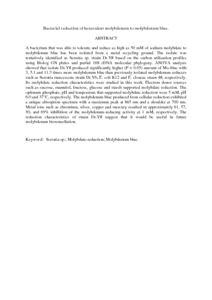Citation
Abd. Shukor, Mohd. Yunus and Rahman, Mahbuba F. A. and Suhaili, Zarizal and Shamaan, Nor Aripin and Syed, Mohd. Arif
(2009)
Bacterial reduction of hexavalent molybdenum to molybdenum blue.
World Journal of Microbiology and Biotechnology, 25 (12).
pp. 1225-1234.
ISSN 0959-3993; ESSN: 1573-0972
Abstract
A bacterium that was able to tolerate and reduce as high as 50 mM of sodium molybdate to molybdenum blue has been isolated from a metal recycling ground. The isolate was tentatively identified as Serratia sp. strain Dr.Y8 based on the carbon utilization profiles using Biolog GN plates and partial 16S rDNA molecular phylogeny. ANOVA analysis showed that isolate Dr.Y8 produced significantly higher (P < 0.05) amount of Mo-blue with 3, 5.1 and 11.3 times more molybdenum blue than previously isolated molybdenum reducers such as Serratia marcescens strain Dr.Y6, E. coli K12 and E. cloacae strain 48, respectively. Its molybdate reduction characteristics were studied in this work. Electron donor sources such as sucrose, mannitol, fructose, glucose and starch supported molybdate reduction. The optimum phosphate, pH and temperature that supported molybdate reduction were 5 mM, pH 6.0 and 37°C, respectively. The molybdenum blue produced from cellular reduction exhibited a unique absorption spectrum with a maximum peak at 865 nm and a shoulder at 700 nm. Metal ions such as chromium, silver, copper and mercury resulted in approximately 61, 57, 80, and 69% inhibition of the molybdenum-reducing activity at 1 mM, respectively. The reduction characteristics of strain Dr.Y8 suggest that it would be useful in future molybdenum bioremediation.
Download File
![[img]](http://psasir.upm.edu.my/13349/1.hassmallThumbnailVersion/Bacterial%20reduction%20of%20hexavalent%20molybdenum%20to%20molybdenum%20blue.pdf)  Preview |
|
PDF (Abstract)
Bacterial reduction of hexavalent molybdenum to molybdenum blue.pdf
Download (85kB)
| Preview
|
|
Additional Metadata
Actions (login required)
 |
View Item |

